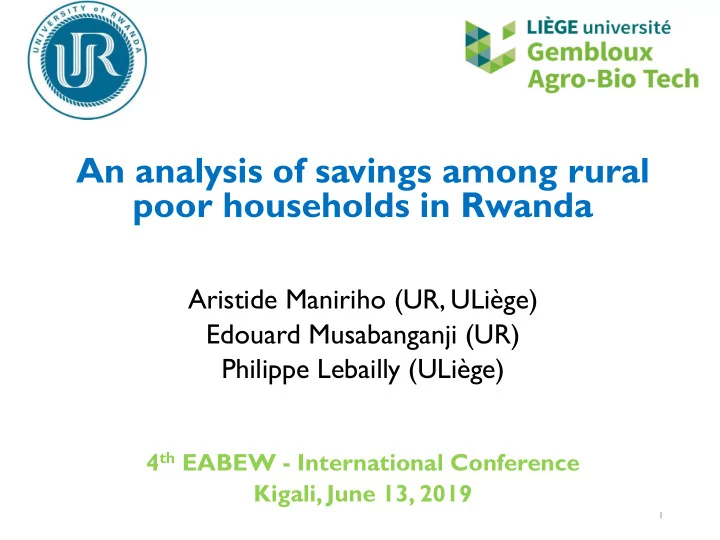

An analysis of savings among rural poor households in Rwanda Aristide Maniriho (UR, ULiège) Edouard Musabanganji (UR) Philippe Lebailly (ULiège) 4 th EABEW - International Conference Kigali, June 13, 2019 1
Outline of the presentation 1. Introduction 2. Materials and Methods 3. Results and Discussions 4. Conclusion and Recommendation 2
1. Introduction • Households savings are a crucial determinant of welfare in developing countries Due to absence of efficient credit and insurance markets • For long, the issue related to whether the poor can save has been raised by scholars • Poor individuals and households make savings using either formal or informal instruments that are highly risky, not cost effectiveness, and with low range of functions (Karlan et al., 2014) . 3
• At microeconomic level, savings has a significant effect on economic development through the provision of investment funds (Attanasio & Banks, 2001) • Individual savings along with salient financial plans are considered as an important factor for sustaining consumption and resilience to income deficits and this results in poverty reduction, especially in the long run (Hulme, Moore & Barrientos, 2015; Dupas & Robinson, 2013). 4
• In Rwanda, there are very few studies on the determinants of savings most of them focused on the macroeconomic aspects (see for example Murindahabi, 2010; Iragena, 2015), consequently, the documentation on household savings is still very rare. This study aims identify the driving factors of private savings in Rwanda with special focus on the rural poor households in Rwanda. 5
2. Materials and Methods (1) Source of Data Data collected by the NISR-Rwanda 5 th cohort of the Cross-sectional Survey on the Households’ Living Conditions /EICV-5 conducted in 2016/2017. Data covers all socio-economic aspects of the households It is a nationwide survey covering rural and urban areas EICV-5 Sample: 14,580 households and 12,054 rural households. Study Sample: only 1,080 rural households due to missing value on interesting variables. 6
(2) Model formulation and Estimation • Following Cameron and Trivedi (2005, 2010), Gujarati (2009) and Wooldridge (2013), a simultaneous-equations model was specified as follows: 7
• Traditional Keynesian models imply that consumption and saving depend on the level of current income (Keynes, 1936). • Household economic and demographic characteristics impact its savings (Tandoh, 2016) . • On the other hand, the household income depends on the production, which in turn depends on the combination of different inputs by the households to create goods and services or wealth (Dieden, 2004, 2005). Use the production as a proxy of income The household income is one of the predictors of the household saving, while the income is determined by the factors that influence the production. 8
(2) Model Estimation and Data Analysis • OLS method is not giving consistent estimators Presence of missing variables, and/or some covariates that are correlated with the error term (Wooldridge, 2013). • The most common approach to use is the instrumental variables (IV) model (Angrist & Pischke, 2009; Fisher, 2010) . The 2-SLS method used as it is the most used estimator of IV regression model, and allows addressing the Endogeneity concern and Simultaneity bias . In the same way, the Durbin-Wu-Hausman specification test (Durbin, 1954; Wu, 1973; Hausman, 1978) showed that the IV- 2-SLS estimates are systematically different from those of OLS (p-value=0.00). 9
Besides, the econometric analysis, other statistical tests were conducted: • A one-sample T statistic was computed to test for the significance of the savings (whether it is statistically different from zero) among rural poor Rwandans. • A two-samples T statistic was computed to compare savings between male and female groups, as well as between the youth and the elder. 10
3. Results and Discussions 1. Level of savings among poor rural households The average is 6,755 RWF, positive and statistically different from zero (p-value=0.000) [Karlan et al. (2014)] 2. Level of savings by gender of the headed poor households The mean savings for male headed households is 6,976 RWF, and that of female headed households is 5,925 RWF, and the difference is not significantly different from zero (p-value =0.32). Men and women benefit equally from all initiated economic opportunities and anti-poverty programs 11
3. Level of savings for youth and elder headed poor households The average savings are 7,017 and 5,657 RWF for youth and elder headed households respectively. The mean savings is statistically the same for the two groups (p-value=0.21). Both the youth and the elder benefit equally all initiated economic opportunities and anti-poverty programs initiated 12
4. The 2-SLS regression estimates: Factors affecting the savings among rural poor households 13
• The most influential determinants of savings among the rural poor in Rwanda are account balance, loan amount, other savings than in FIs (financial institutions). • The Farm income and all other forms of income are not among the significant drivers of the savings, while Consumption) (correlated with savings, p=0.00) is among the significant drivers of the rural poor in Rwanda. • The consumption is among the key indicators of wealth among households in the context of developing countries (Dercon et al., 2009; Islam & Maitra, 2012) . The higher the consumption, the higher the savings, and thus the better the welfare status of the household 14
4. Conclusion and Recommendations • This study attempted to analyze the factors affecting the savings among rural poor households. • The analysis shows that the most influential drivers of the savings among the rural poor are account balance, loan amount, other savings than in FIs (financial institutions), locational factors (province, district and villages). • The Farm income and all other forms of income are not among the significant drivers of the savings, while Consumption is among the significant drivers of the rural poor in Rwanda. • From these findings, we recommend that socioeconomic development programs, projects and/or policy initiatives that take into account the identified drivers of the savings among rural poor households should be enhanced. 15
Thank you for your kind attention 16
Recommend
More recommend